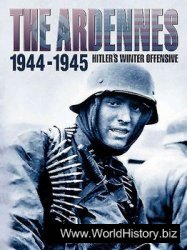One of General Bradley’s tasks was to reduce the "fortified area of the Ruhr” where, on Hitler’s orders, Field-Marshal Model had shut himself in. Given the job of carrying out the operation, the American 15th Army attacked southwards across the Ruhr and westwards across the Sieg.
By April 12, Lieutenant-General Gerow had occupied the entire coal basin in which, despite the Fiihrerbefehl of March 19, the Germans had done nothing to add to the destruction wrought by British and American bombing. Two days later, the pocket had been cut in two from north to south. In these conditions, Colonel-
General Harpe, commanding the 5th Panzerarmee, recognising the fact that his chief had disappeared, ordered Army Group "B” to cease fighting. Capitulation delivered 325,000 prisoners (including 29 generals) into Allied hands. A vain search was instituted for Field-Marshal Walther Model, and it was learnt only four months later that he had committed suicide on April 21, lest he be handed over to the Russians after his surrender, and had been buried in a forest near Wuppertal.
Without waiting for the outcome here, the American 9th, 1st, and 3rd Armies exploited their advance to the full. Resis-
<< Propaganda, like the poster opposite exhorting soldiers and civilians to work for victory, continued up to the very end of the war, boosting the morale of the German people which did not crack until defeat became inevitable.
V American infantry press on into Germany past an enormous concrete air raid shelter in Aachen. Parked in the lee of the building is a Sherman tank.
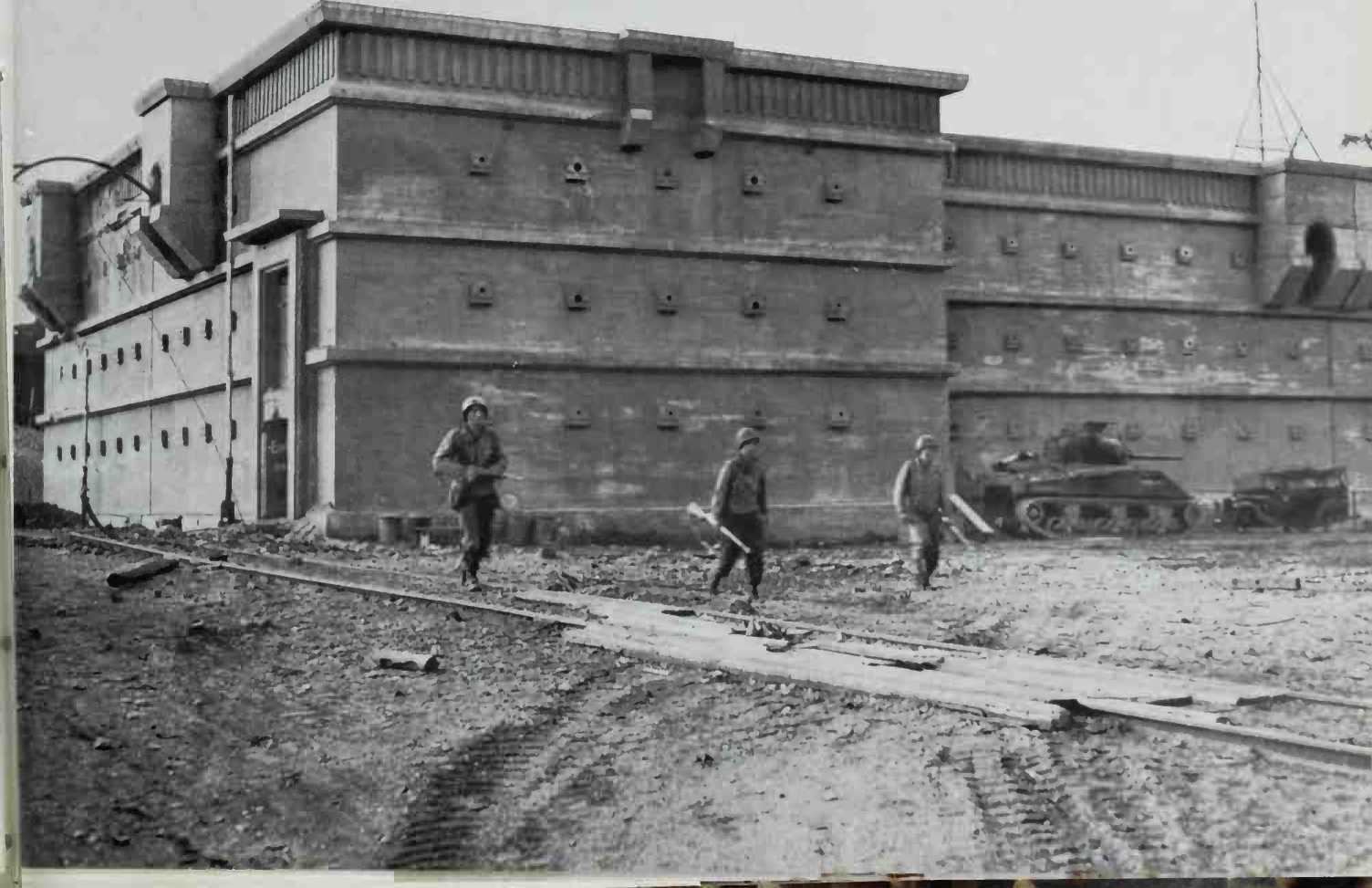
V An American 9th Army infantryman shelters behind a blasted tree as a road mine is exploded. Note the Sherman flail tank on the right, waiting to go into action. The sloping box at its rear contains chalk dust to mark the path cleared.
> American soldiers examine a Messerschniitt Me 262 fighter-bomber found in the outskirts of a wood. Note the 20-mm cannon shells in the foreground.
V > Two soldiers with their families surrender to the British.
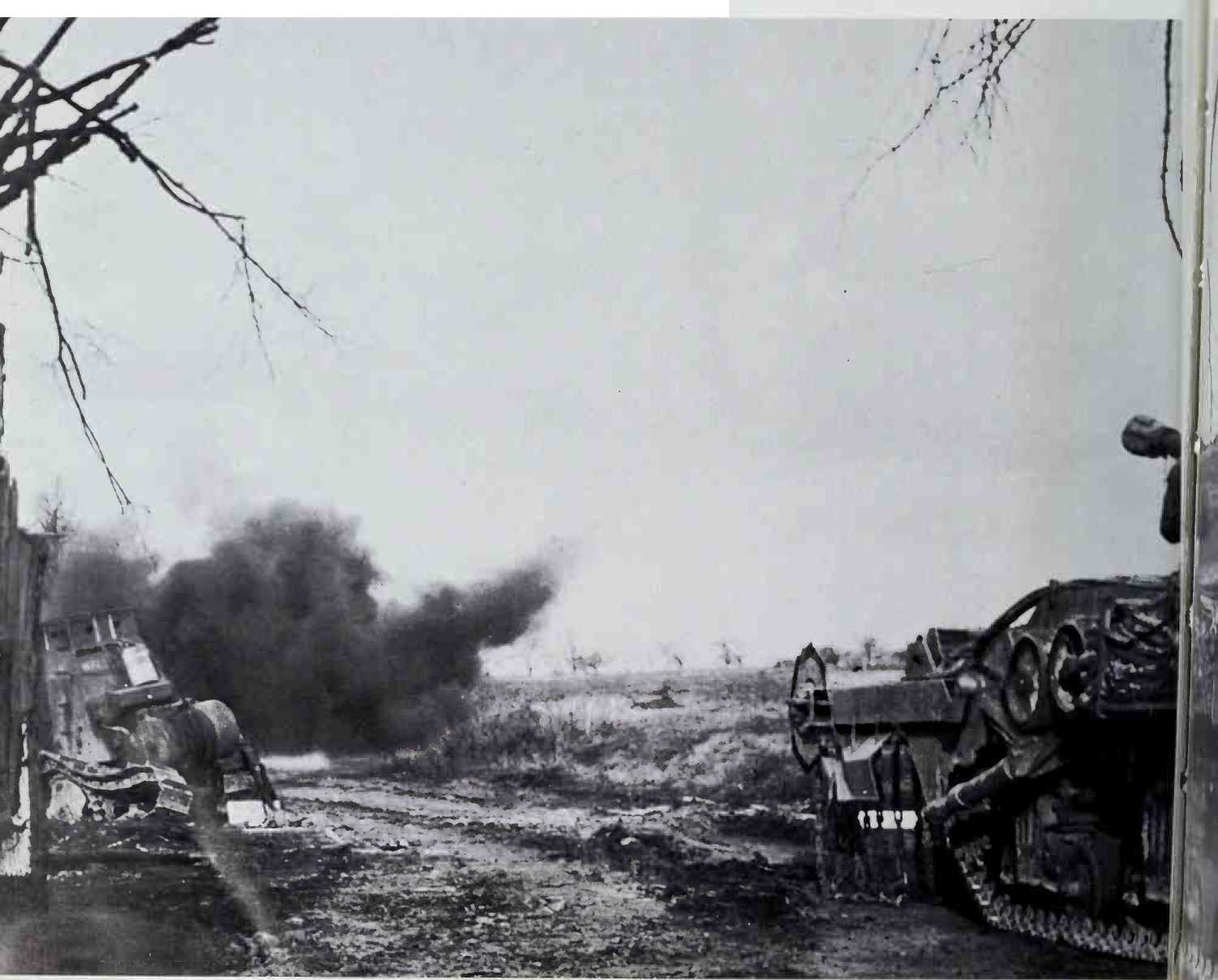
Tance grew weaker every day, and the average daily haul of prisoners rose from 10,600 between February 22 and March 31 to 29,000 for the week April 2 to 9, and reached 50,000 in the middle of the month. Evidently, the Landser (German "Tommy”) was at the end of his tether, in spite of the growing wave of drumhead courts martial and summary executions. In the heart of the Reich, the multiplication of divisions went on almost to the final day, but whether they belonged to the Wehrmacht or to the Waffen-S. S., these new divisions, Volksgrenadier for the most part, revealed the paucity of their training as soon as they came under fire.
The Volkssturm, which was intended to fill the gaps in defence, was a pitiful ragbag of middle-aged men and adolescents, armed and equipped with any weapon that came to hand. Witness the battalion leader, taken prisoner by the Canadian Army, who confided to Major
Shulman:
"T had 400 men in my battalion,’ he said, 'and we were ordered to go into the line in our civilian clothes. I told the local Party Leader that I could not accept the responsibility of leading men into battle without uniforms. Just before commitment the unit was given 180 Danish rifles, but there was no ammunition. We also had four machine-guns and 100 anti-tank bazookas (Panzerfaust). None of the men had received any training in firing a machine-gun, and they were all afraid of handling the anti-tank weapon. Although my men were quite ready to help their country, they refused to go into battle without uniforms and without training. What can a Volkssturm man do with a rifle without ammunition! The men went home. That was the only thing they could do.’”
In these conditions, allowing for sporadic but short-lived retaliation here and
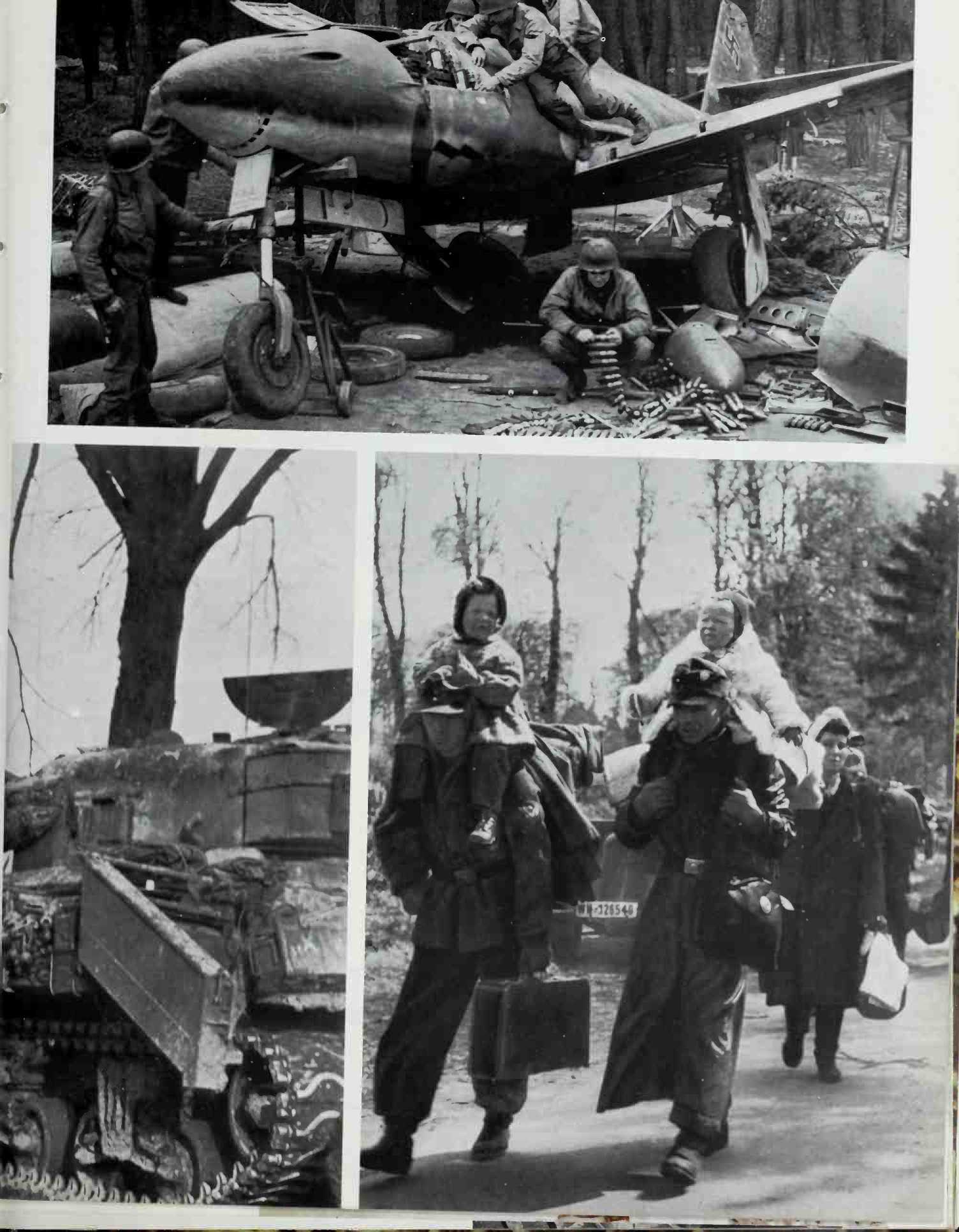
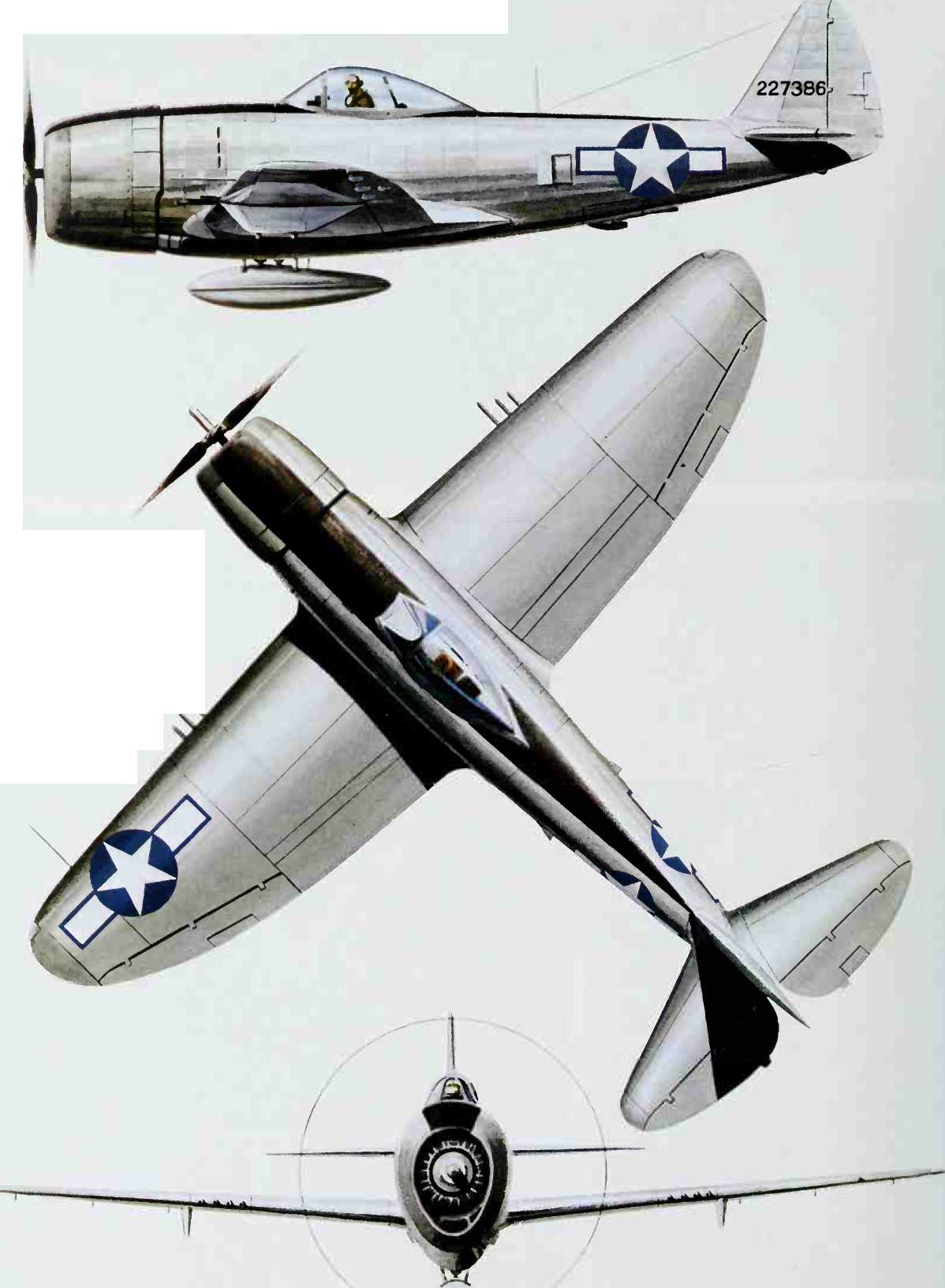
The American Republic P-47M Thunderbolt fighter
Engine: one Pratt & Whitney R-2800-57 radial, 2,800-hp Armament; eight.5-inch Browning machine guns with 425 rounds per gun.
Speed: 470 mph at 30,000 feet. Climb: 3,500 feet per minute at 5,000 feet.
Ceiling; 44,000 feet.
Range: 560 miles without drop tank. Weight empty/loaded; 10,423/
1 5,500 lbs.
Span: 40 feet 9| inches.
Length: 36 feet 4 inches.
Height: 14 feet 7 inches.
2180
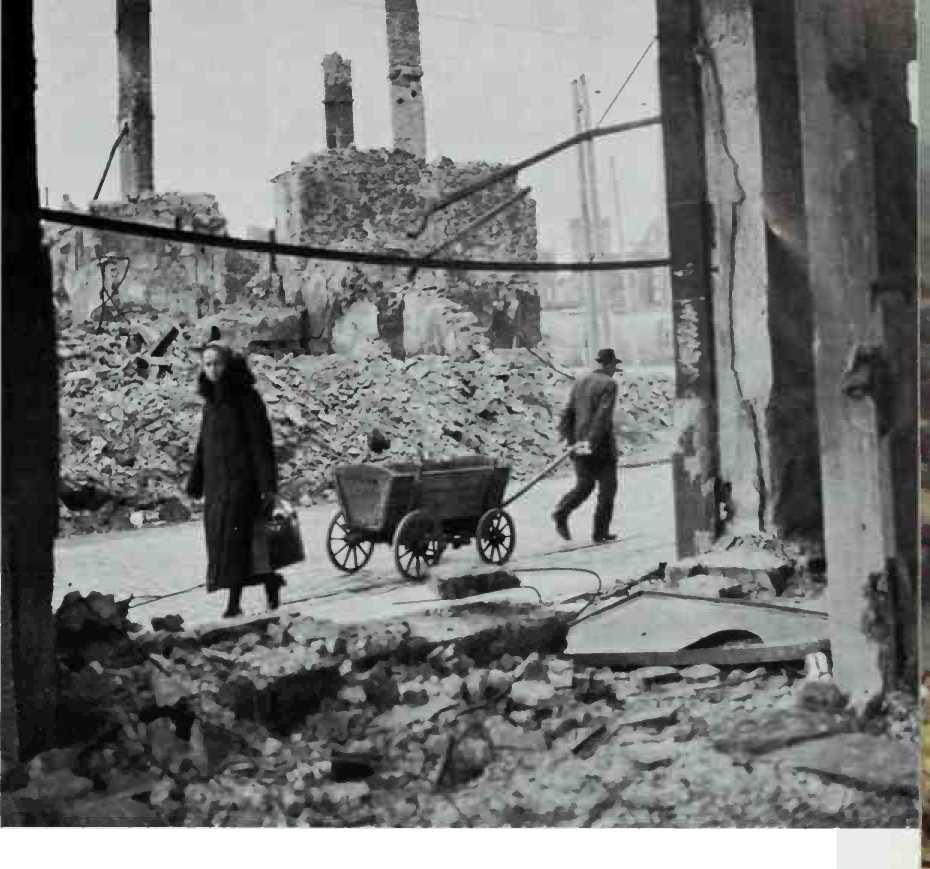
There from a few units that still retained some semblance of order and strength, the advance of the 12th Army Group across Germany gathered speed and took on more and more the character of a route march, facilitated by the Autobahn system, which in by-passing the towns removed inevitable bottlenecks. As a result, American losses dropped to insignificant figures. In the 3rd Army, according to Patton’s record, for three corps of 12, then 14, divisions, between March 22 and May 8,1945, they amounted to 2,160 killed, 8,143 wounded, and 644 missing, under 11,000 in all, compared with nearly 15,000 evacuated because of sickness and accidental injury.
On the left of the 12th Army Group, the American 9th Army, straddling the Autobahn from Cologne to Frankfurt-am-Oder to the south of Berlin, thrust towards Hannover, which it took on April 10, and three days later reached Wol-mirstedt on the left bank of the Elbe, 85 miles further east. With the capture of Barby, slightly upstream of Magdeburg, it established a first bridgehead on the right bank of the river, thus putting its 83rd Division (Major-General R. C. Macon) some 75 miles from the New Chancellery. But then it turned instead towards Dessau and made contact there with the 6th Armoured Division (Major-General G. W. Read), which was moving ahead of the 1st Army.
The 1st Army had crossed the Weser at Miinden and driven across Thuringia on a line linking Gottingen, Nordhausen, and Eisleben, covering nearly 80 miles between April 8 and 12. As has been mentioned above, it was its left flank that made contact with the 9th Army’s right. This pincer movement cut off the retreat of the German 11th Army, which had stayed in the Harz mountains as ordered. To clear a way through for withdrawal, O. K.W. sent the "Clausewitz” Panzer Division to the rescue. It attacked at the junction between the 21st and 12th Army Groups and inflicted some damage on the 9th Army. But having got 35 to 40 miles from its point of departure, in the region of Braunschweig, it too was enveloped and annihilated. The same fate struck the 11th Army, falling almost to a man into Allied hands.
In the centre of the 1st Army, VllI Corps, after reaching the Elbe, managed to establish a bridgehead at Wittenberg, while to its right, VII Corps took Halle and Leipzig on April 14. The capture of Leipzig was a combined effort with the 9th Armoured Division, from the 3rd Army. In accordance with his instructions, General Hodges waited for some days on the Mulde, and it was only on April 26 at Torgau that he met up with Colonel-General Zhadov, commanding the Soviet 5th Guards Army. In the course of this rapid advance the 1st Army came across 300 tons of Wilhelmstrasse archives deposited in various places in the Harz. At Nordhausen, it occupied the vast underground factories where most of the V-1 and V-2 missiles were manufactured.
On March 30 the impetuous Patton was on the Werra and the Fulda. On April 12, the 3rd Army, changing its direction from north-east to east, crossed the Saale at Naumburg, Jena, and Saalfeld, having broken the last serious resistance offered by the enemy at Miihlhausen in Thuringia. And on April 7 the 3rd Army took the 400,000th prisoner since its campaign opened. On the 21st following, XX Corps reached Saxony and the vicinity of Chemnitz, VIII Corps reached a point beyond Plauen, while XII Corps, changing course from east to south-east, had got well beyond Bayreuth in Bavaria. This was the last exploit by Manton S. Eddy
A Germany in e. xtremis: bombed mereilessly, short of food, and without motor transport as a result of the fuel shortage. This is Darmstadt, whieh fell to the 26th Division of the U. S. 3rd Army.
Overleaf top: An unfortunate reminder of better days in shattered Rheydt-"Vhat have you done for Germany today?” Overleaf bottom; German eivilians and their proteetion against stray bullets.
Page 2183: An American motor transport eolunin, headed by a jeep, wends its way into Germany.
2181

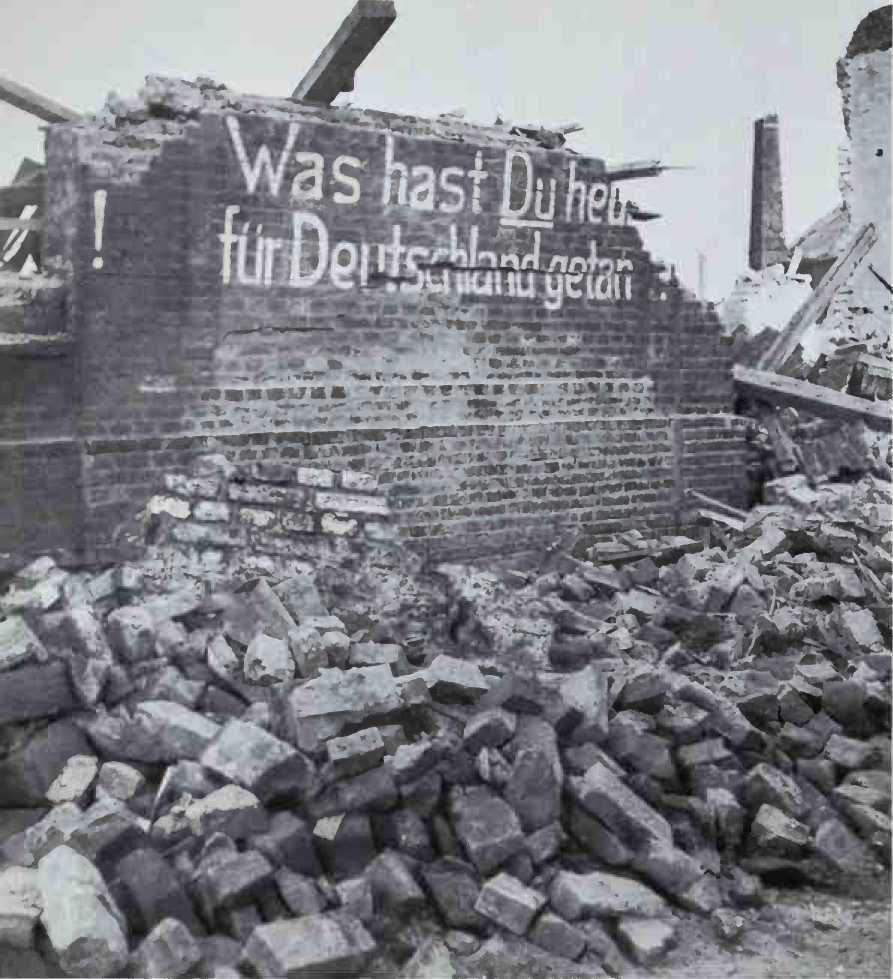
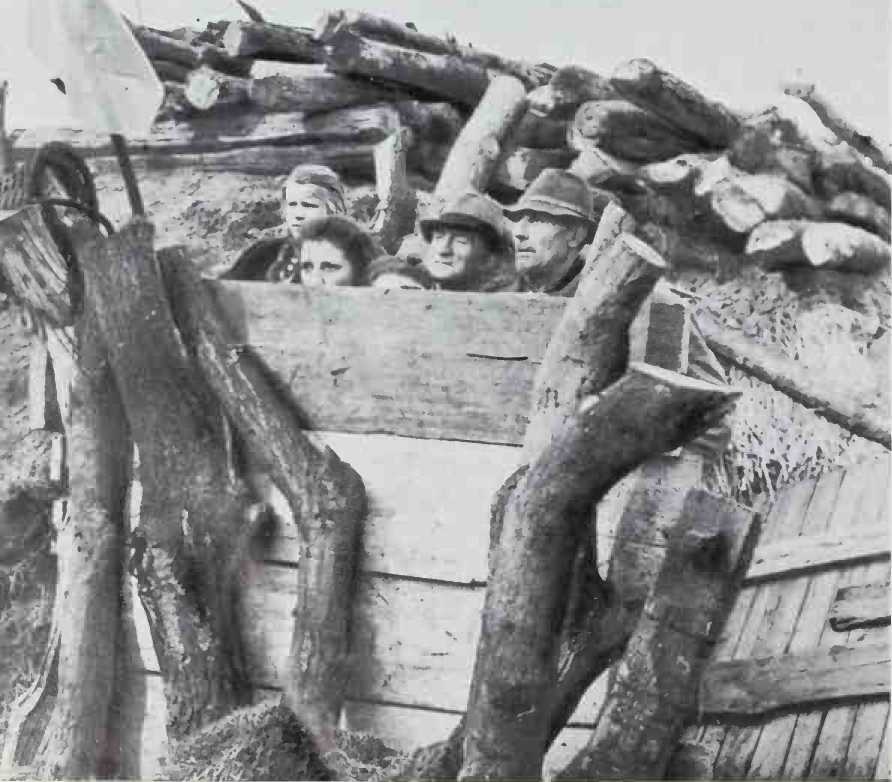
Who suffered a heart attack and had to hand over his corps to Major-General Stafford LeRoy Irwin. If the 1st Army had captured the Wilhelmstrasse archives, the 3rd discovered the last reserves of the Reichsbank, composed of gold bars worth 500,000,000 francs, small quantities of French, Belgian, and Norwegian currency and 3,000,000,000 marks in notes.
An ultimate regrouping by Bradley switched VIII Corps from Patton’s command to Hodges’s, and the progressive collapse of Army Group ”B” permitted III and V Corps to be switched to the 3rd Army. Thus strengthened, it was given the assignment of supporting the activities of the 7th Army in Bavaria and upper Austria; specifically, to prevent the enemy establishing himself in the "national redoubt’’ zone, which General Strong, head of S. H.A. E.F. Intelligence, in a memorandum dated March 11, depicted as follows:
"Here, defended both by nature and by the most efficient secret weapons yet invented, the powers that have hitherto guided Germany will survive to reorganise her resurrection; here armaments will be manufactured in bombproof factories, food and equipment will be stored in vast underground caverns and a specially selected corps of young men will be trained in guerrilla warfare, so that a whole underground army can be fitted and directed to liberate Germany from the occupying forces.’’
Patton advanced with all speed, and on the day of the surrender he had pushed his XII Corps to a point ten miles below Linz on the Austrian Danube, and his HI Corps, whose command had been taken over by Major-General James A. Van Fleet, as far as Rosenheim at the foot of the Bavarian Alps. On May 2, his 13th Armoured Division (Major-General Millikin) crossed the Inn at Braunau, birthplace of Adolf Hitler, who had just committed suicide in his bunker in the Berlin Chancellery.
Patton would have liked to complete his triumph by maintaining the drive of V (Major-General Clarence R. Huebner) and XII Corps as far as Prague. But on May 6, Eisenhower sent him categorical instructions via Bradley not to go beyond the Ceske Budejovice-Plzen-Karlovy Vary line in Czechoslovakia which he had reached. By this action, the Supreme Allied Commander, who had consulted Marshal Antonov, Stalin’s Chief-of-Staff,
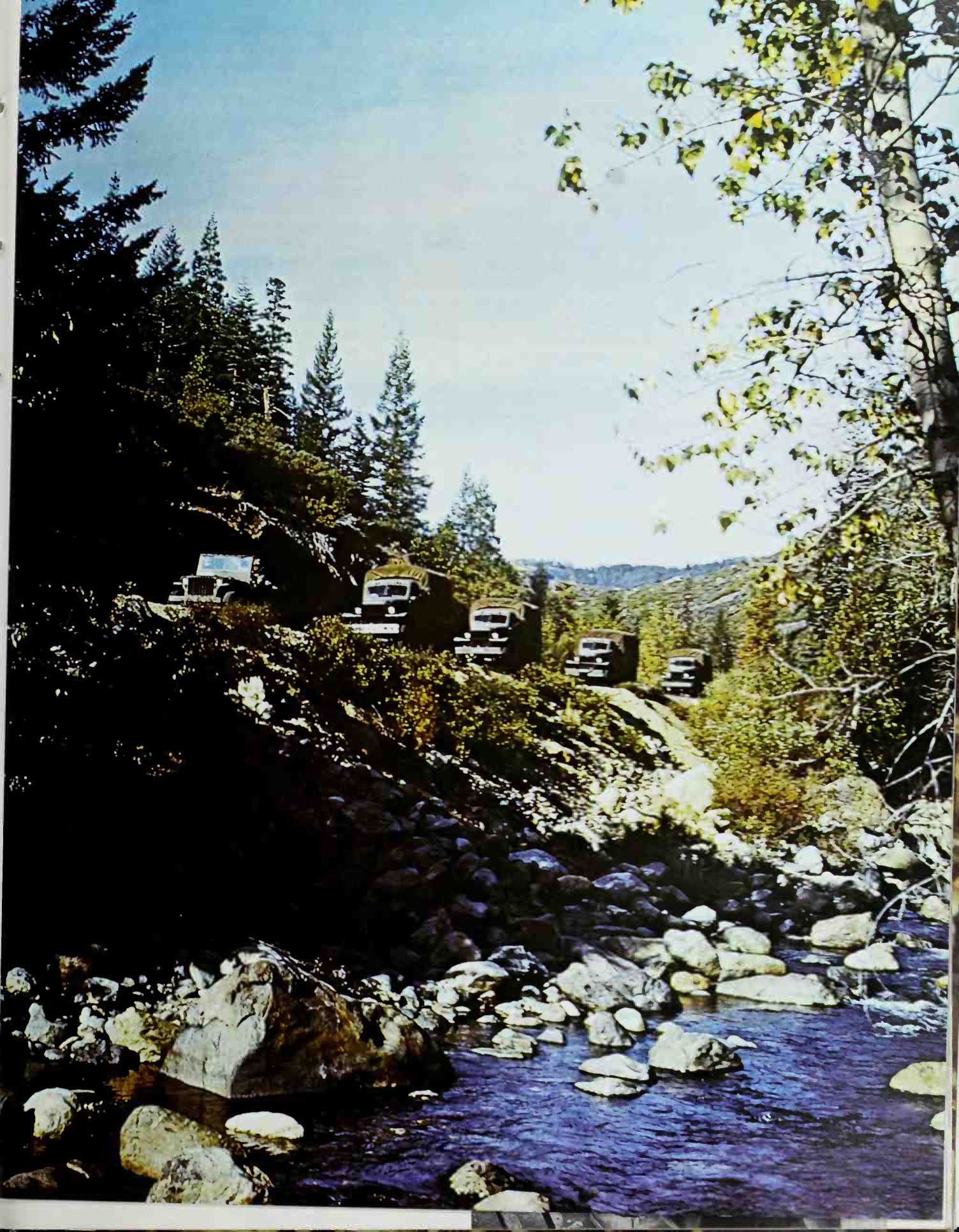
On the matter, yielded to the objections such an operation raised in the Soviet camp. In any event, the American 3rd Army met the spearhead of the 3rd Ukrainian Front, which had come up the Danube from Vienna, at Linz.




 World History
World History





